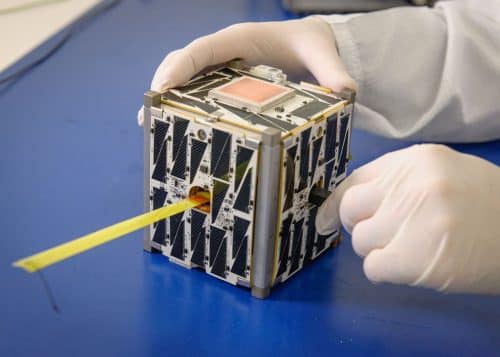The center will build and launch dedicated nanosatellites for scientific research in a variety of fields. Possible missions of the tiny satellites: monitoring air pollution, tracking rainforests and glaciers, agricultural applications, communication networks and more

Tel Aviv University is establishing a 'New Space' center, which is based on an innovative approach to space research: the use of dedicated tiny satellites, which are specially built to answer specific scientific questions. The satellites, assembled in a short time and at relatively low costs, will make satellite technology accessible to the scientific community all over campus.
The initiative is supported by the Porter Foundation, and the center will be located in the Porter School of Environmental Studies. It will employ experts and engineers, who will build each satellite in collaboration with Tel Aviv University faculty and students who initiated the research.
The president of Tel Aviv University, Prof. Yosef Klefter, will report on the new center at the international space conference that will open next week at Tel Aviv University.
"Until recently, scientists who wanted to use satellites for their research needed the services of large satellites, usually launched by governments and armies," says Prof. Colin Price, head of the Porter School of Environmental Studies, who led the initiative in collaboration with Dr. Meir Ariel, head of the Herzliya Science Center. "The 'new space' method frees them from this dependence, and allows them much greater flexibility in using satellites for research purposes."
The 'new space' approach, made possible thanks to the technological miniaturization revolution, is based on cubes measuring 1010x10xcm, which are used to assemble tiny satellites ("the size of a shoe box"). Each tiny satellite is equipped with a variety of tiny cameras and/or sensors, according to the mission for which it is intended, along with a communication system that allows it to be commanded and send data to a receiving station on Earth, explains Dr. Meir Ariel. Building a tiny satellite takes about two years - compared to 10 and even more for a large satellite, and the cost of construction and launch reaches about half a million dollars - compared to the hundreds of millions of dollars required for a traditional satellite.
The tiny satellites 'ride' into space on the backs of spacecraft launched around the world, and enter orbit around the Earth at an altitude of 600-400 km. They move at a speed of 8 km per second, and circle the earth every 90 minutes. Tiny satellites of this type can be used for research in a huge variety of fields: environmental monitoring, air pollution, tracking the rainforests, polar ice caps or animal migration, agriculture, communication networks, geophysics, geography, atmospheric research, meteorology, biology, medicine and more.
In addition to its research activities, the center will also engage in educational and engineering activities, and will build programs for training students in the field of space sciences, space engineering and satellites, explains Dr. Ofer Amarni from the Faculty of Engineering at Tel Aviv University. He is also expected to take part in the project The 'Israel 70' project': Building tiny satellites in 70 high schools all over the country, and launching them into space, to mark the country's 70th anniversary.
"Our center is driven mainly by scientific questions", Prof. Price concludes. "This is a multidisciplinary center, designed to be used by researchers all over the campus - from the exact sciences, engineering and life sciences to the social sciences, education, law and even art. Alongside the research activity, we will also engage in teaching and education, with the aim of training the next generation of experts in the fields of space and satellites."
See more on the subject on the science website:
- A missile was born: get to know the small satellite launcher "Electron"
- Exclusive: "Israel 70" project - launching a group of 70 satellites into space to mark the 70th year of independence for the State of Israel
- The Technion will launch the first autonomous satellite fleet into space
- The children overcame all the obstacles that were on the way in the development of the Dokifat 2 satellite
- ExoTerra presents - the engine that will bring small satellites to an asteroid
